We'd arrived in Jaipur late the night before after an exciting, i.e. somewhat hair raising, bus ride from Agra. The three cities of Agra, Jaipur and Delhi are known as India's Golden Triangle. Jaipur is the capital of the state of Rajastan and because of its ubiquitous pink color, is known as the 'Pink City' since the whole city was painted pink for a visit by the Prince of Wales. Spread out at the foot of the Aravalli Mountains, the old walled town was laid out in the eighteenth century in a grid formation resembling a giant chessboard.
After enjoying a pleasant breakfast on the rooftop terrace
restaurant, we decided, close to 11, to finally start seeing the sights in
Jaipur. The hotel thought the cost to hire one of the many tuk tuks waiting
outside to drive us to City Palace Complex would be 50 INR, aka rupees, or just .75. When we asked the drivers though, their
costs ranged from 80 to 200 INR, a sizable variation, but still a paltry amount by North American standards.
We chose the least expensive one and arrived at the City Palace's
Photos en route to City Palace:
The City Palace Complex was created in the 1720s by order of Maharaja Jai Singh 11, the founder of Jaipur, and includes the main attractions of the city in addition to Rajastan government building. The entire complex was surrounded by a huge wall that backed onto private homes, stores and small temples.
Deepak, the tuk tuk driver who took us to the City Palace.
The entrance to the Maharaja Museum.This part of the palace complex belongs to the Jaipur's Royal Family who still live in the central building.
In the
center of the first courtyard was the Mubarak Mahal or Welcome Palace
Sawai Man Guards: The unit began in the sixteenth century and was
reorganized in 1932 after their name was changed a number of times. At the
outbreak of World War 11, the unit saw service in Eritrea , Palestine and Italy and later in Hong
Kong and in operations in Kashmir
against tribal raiders. There were 2 prerequisites to being eligible for this
elite company: you had to be at least 6 feet tall and a Rajput, i.e. a member
of one of the Indian patrilineal clans.
No photos were allowed inside the museum; I paid attention
to the sign that indicated violators were subject to a 500 rupee fine - $7.50 - for a few minutes but I couldn't resist taking a photo of the gorgeous, but massive, Benares silk robe belonging to Madho Singh 1, one of the former leaders of Jaipur. He was more than six and a half feet tall and weighed in excess of 440 pounds!
One of the two
Photos from the Palace Armory:
A guard explained to me that the 'No Photos' rules inside the City Palace Complex began in
1959 and that the 400 rupee fine had not changed since then!
Photos of Janta Mantar below:
Our first image was of the Unnatamsq above and below. It measured altitude - the angular height of an object in the sky.
Next up was the Yantra Raj, an adaptation of an Astrolabe, a medieval instrument which measured time and the position of celestial objects. We learned that Yantra means instrument.
Above, an idea of the scope of Jantar Mantar.
Steven in front of the equatorial instrument Nadivalaya.
Photo showing exact time at Nadivalaya, i.e. 1:25, from
sun’s shadow.
The Dhruvdarshak Pattika, above, was perhaps the simplest of all the instruments found in the Observatory. It is a form of a small trapezoidal structure whose upper surface points toward the Pole Star on a clear dark night. The angle in the triangular wall is supposed to be equal to the latitude of the Observatory's location. This instrument was the compass of an earlier age.
Photos of Laghu Samrat Yantra:
The sundial measured the exact solar time in Jaipur with
an accuracy of 20 seconds! It was interesting to discover that the solar time in Jaipur was some 10-41 minutes from the official time in the rest of India.
The Ringed Instrument or Chakra Yantra measured the global coordinates of declination - the angular distance north or south from the celestial equator - and the hour angle of a celestial object.
Photos of the Rasivalaya:
All the signs of the zodiac were
included as part of the Rasivalaya or instruments used to measure
the celestial latitude and longitude of the celestial bodies.
There were 12 instruments which represented the 12 signs of the zodiac, one for each measurement to be done when the corresponding sign of the zodiac crosses the meridian.
More photos of the massive Jantar Mantar to pique your interest:
We saw the small Bihar
Temple, above, that was located on the grounds of the Observatory.
We left Jantar Mantar at 2ish
by bicycle rickshaw initially but felt too guilty when the old man above had difficulty riding the bicycle and navigating it through the heavy traffic.
We then continued on foot toward
the nearby Hawa Mahal below.
The Hawa Mahal or Palace of the
Winds was situated within the
walled precincts of the City Palace Complex. The purpose of the palace was to
watch and observe and to see without being seen. Now Hawa Mahal is virtually
nothing but a facade. Built in 1799, it was a gigantic screen from
behind which the women of the palace could enjoy watching life on the street,
cooled by the air flowing through some of the 61 lattice-work windows while at
the same time observing the strict rules of purdah that forced them to remain hidden from
the eyes of strangers.
Photos from Hawa Mahal:
The 5 storied building had 2 large courts and we took the time to walk through the maze of corridors to both the courts and to each of the stories!
We kept walking up ramps to the next levels finally reaching
the top.
I continued to be amazed at the number of times locals,
especially young people, wanted to take my picture, either alone or with them too. It happened again a number of times while we walked around Hawa Mahal. I could have more readily understood
when that occurred in parts of China
where there were fewer Western tourists but was at a loss to explain why it also occurred in
such major cities as Jaipur, Agra ,
etc.
Tiny windows women could look out of without being seen
through the intricately carved lattice screens.
Above and below, views from the top of the Observatory, the tall Minaret or Isarlat, City
Palace
After poring over maps and tour guides at Hawal Mahal trying
to decide where to head next, we left about 3:15 .
The exit from Hawal Mahal was through a long series of
corridors that never seemed to end. We ended up spending the next couple of hours just walking through the center of Jaipur following information we had about a walking tour but just meandering more than anything and going where we felt like it.
Photos of our wanderings through Jaipur:
Most of the buses we saw were pink because of the city being called the Pink City as I mentioned above.We loved the vibrant colors in the market stalls.
We weren't such big fans of the traffic though!
Also could have done without having to dodge cows on the sidewalks and streets!
This photo gives you a good sense of why Jaipur is known as the Pink City. Virtually all the architecture was like this.
Above and below, one of the Hindu temples we passed.
Photos from the temple:
One of the many gates in the city walls.
For all my knitting friends!
We saw a number of these ancient cars in Jaipur.
We walked through a number of markets and watched clothes being dyed - now that was a first! Kishanpol Bazaar was known for its textiles and tie dyed cloth.
We had hoped to climb to the top of the Minaret or the Isarlat that we had seen it from Hawa Mahal and was the tallest structure in Jaipur but we discovered once we got there that it was closed to the public.
Liked the gaily decorated trucks we saw in Jaipur.
Adam: I thought of you when we saw this store!
More dying of fabrics!We saw a sign for a gallery atop a building so climbed the steps and entered the small shop below that was owned by the woman on the left. Her daughter though was the de facto sales person and had infinite patience as she told her mother what to bring out to show us from the large variety of paintings packed away in drawers. We ended up buying 2 beautiful botanical pictures that are being framed as I write this.
By the time it took us to decide on which pictures though, it had gotten late and dark, so the daughter escorted us back down to the street below and kindly negotiated a taxi price with one of the waiting tuk tuk drivers. The big 'excitement' for me was that I got headbutted by one of the wandering cows as I crossed the street - luckily I wasn't hurt, except for my pride, that is!
Posted on 1/6/16 from our home in Littleton, Colorado.
































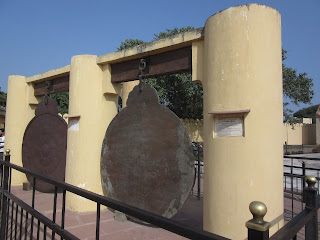











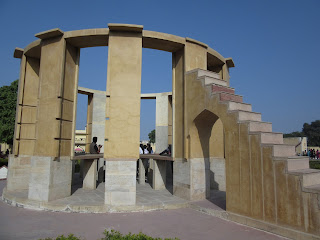




















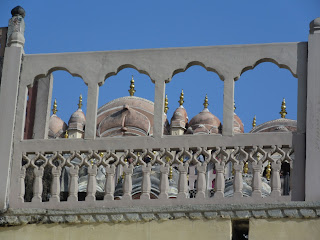
















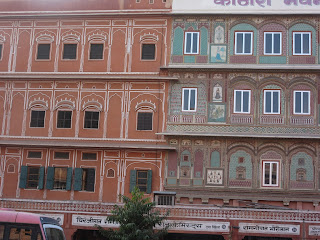
























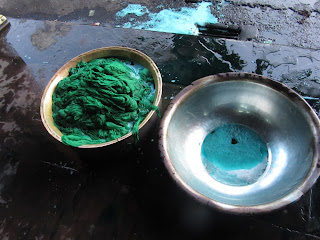














Wonderful city. Watch out for those cows!!!!
ReplyDelete